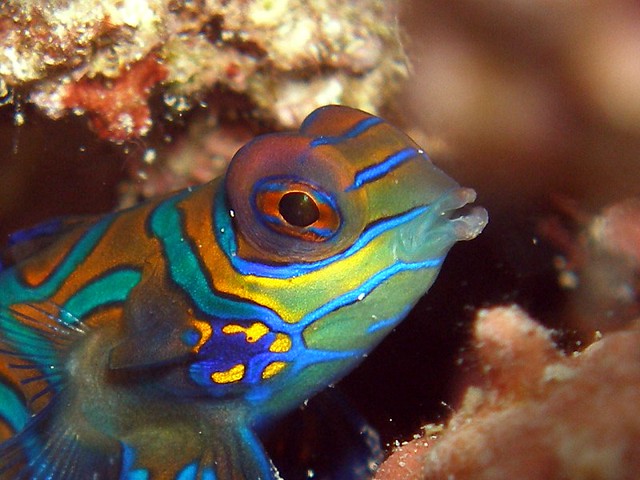 |
Photo by leafbug  |
This is one of the most beautifully colored fish in all of nature. It color palette looks like it came straight from one of the polyester shirts popular in the 70s. A psychedelic montage of oranges, yellows and greens coalescing across a neon blue body make this fish a sure standout in any aquarium. Its vivid coloration evokes the rich color patterns and embroidered adornments on the robes of an Imperial Chinese Mandarin. This coloration makes for ideal camouflage against the brightly colored species typical of a tropical marine reef formation. They are sold under a variety of trade names including striped mandarin fish, mandarin dragnet, striped dragonet, green dragonet, mandarin goby, green mandarin, and even the psychedelic mandarin fish. One would think a species of such exotic magnificence would fetch a hefty price. In reality, these are very affordable fish.
Dragonets account for 10 genera and more than 182 species of the 267 genera and 2,100 species collectively referred to as gobies. Gobies are small fish. A fully grown adult mandarin will only reach between 2.5 and 4 inches in length. This is a mild-mannered creature and should not be housed with more aggressive species or fish large enough to view it as an appetizing snack. In nature, they often commune in small groups. However, in the confines of an aquarium two males may demonstrate territorial behavior toward one another. Keeping a male and a female together will not present a problem. This is a timid fish. Avoid having lots of other bottom dwellers in your community tank.
The Mandarin is more likely to starve itself to death rather than compete for its food. It will also require plenty of hiding places. This is a suitable candidate for a reef aquarium. It does consume crustaceans but they are much smaller than the ones you would purchase to populate your reef tank. Do not keep them with sea anemones as you may well wake up with one less fish in your aquarium. Mandarins secrete a toxin in their mucous that covers their bodies as a form of protection against predation. However, this toxin will not affect the other members of your aquarium as long as they do not attempt to eat the mandarin.
Mandarinfish are recommended for expert aquarists only. This is specifically because of their specialized diet in nature. This omnivore's diet is largely comprised of amphipods (small shrimp-like crustaceans), copepods (planktonic sized crustaceans), Gastropoda (tiny univalve mollusks) and polychaete worms.
Mandarins will often succumb to a death of malnutrition within the first six months of captivity. Many simply cannot make the transition to life in an aquarium. It is highly recommended that you ask to watch the one you intend to purchase feed before taking it home. Providing plenty of well established live rock and living sand as a substrate will help in the acclimation process.
Despite its troubles adapting to a life of captivity, mandarins are a hardy and highly diseases resistant species. They have scale-less bodies and a skin type that is naturally immune to ichthyophthirius (ich). Mandarins who successfully acclimate to aquarium life are healthy active fish that can easily live in excess of 10 years possibly even as long as 15.
It is relatively easy to sex mandarins. Males are generally larger than females. The male's dorsal fin is more elongated and pointed than that of the females. This fish has been known to breed in captivity.
Technological advancements in the aquarium industry continually redefine the concept of "home aquarium ownership." Just twenty years ago not even the biggest public aquarium was capable of keeping jellyfish alive in captivity. Now they make desktop Jellyfish Fish Tank Aquariums. And why would you want a jellyfish tank? Perhaps you should check out what the translucent bodies of Pet Moon Jellyfish look like under LED lighting. Pet Jellyfish give a whole new meaning to the term exotic pets.
Article Source: EzineArticles
|

No comments:
Post a Comment